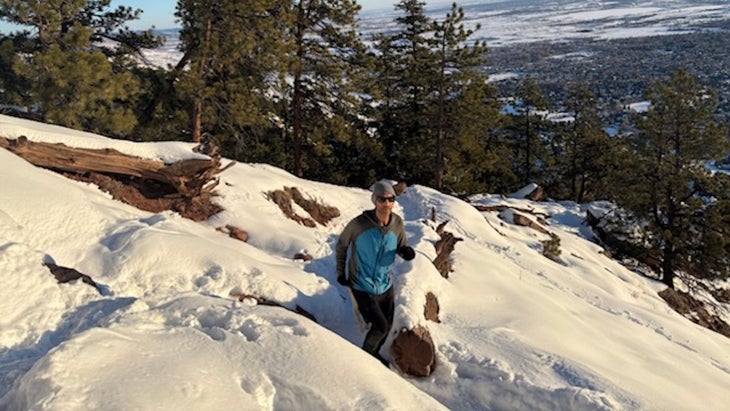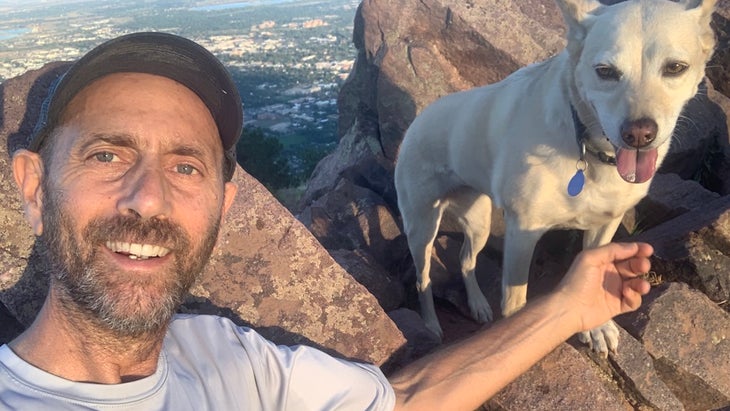My favored route to the top of Mount Sanitas, in Boulder, Colorado, gains some 1,200 feet in just over a mile. It starts on the aptly named Goat Trail and then climbs the East Ridge Trail to the 6,800-foot summit. There are much better trails for running in Boulder—less rocky, less steep—but I prefer this route up Sanitas because it has a great view, it’s near my home, and, if nothing else, it’s very efficient.
I’m not a particularly good runner, definitely not fast, but I am consistent. Over the last 15 years, I’ve chugged up Sanitas more than 2,000 times. Occasionally I’ll mix it up with one of those other Boulder trails, where the grade is more running-friendly and my dog can chase new smells, but we always come back to Sanitas. Which is to say, I know the route to the top really, really well. I know where wildflowers appear in yellow and purple bunches in late spring and where ice persists long after winter storms. I know where water pools after summer rain and which pine trees smell like butterscotch.
And I certainly know my pace. The ascent takes me about 30 minutes, depending on how many times I have to pick up my dog’s poop. (I once made it to the top in 22 minutes, without the dog, which isn’t bad for a middle-aged desk jockey, but for context, Kilian Jornet ran the nearly identical in 14 minutes and 12 seconds, according to).
Even at my slowest, though, I’m at least maintaining a steady jog. So I knew something was different when I suddenly stopped running halfway up. Weird, I thought, as I slowed to a walk with no conscious decision to downshift. It was a bright April day, perfect conditions, and I was glad to be back on Sanitas after a couple of weeks out of town. I had been put-putting along like normal, on a section of trail that steepens considerably after a couple of long switchbacks, and then suddenly I was walking. It felt like running underwater: I was telling my legs to run, but they just wouldn’t go any faster.
I felt fine in every other way—no pain, nothing. I was breathing hard but that’s normal on a trail that ascends more than 1,000 feet per mile. This must be what serious athletes mean by hitting the wall, I thought. But why was I bonking on a trail I know so well? I continued to swim-walk, considering possibilities. Did I need to re-acclimatize to the altitude after being at sea level for two weeks? Did I have a virus that was sapping my energy? Were the effects of aging unfolding the same way Earnest Hemingway, in the Sun Also Rises, described the process of going bankrupt: gradually, then suddenly?

More than a decade ago, surprising research sparked sensational headlines suggesting that endurance training might be bad, not good, for your heart. Articles like “” captured the spirit of the moment. The counterintuitive results of these studies turned out to be flawed, but they did jumpstart a series of investigations into the relationship between endurance training and cardio health.
Alex Hutchinson, ���ϳԹ���’s Sweat Science columnist, has written extensively about the subject. Most recently he dug into the latest news in “Two Promising Updates on Heart Health in Endurance Athletes.” The upshot? It’s clear that endurance training affects the heart, but it’s difficult to say exactly what the changes mean. For example, one study found that masters endurance athletes have elevated scores compared to non-athletes, which on the surface is not good. Higher levels of arterial calcium are associated with a higher risk of serious and potentially fatal heart problems in the general population. That’s because calcium deposits are a sign of possible plaque buildup on the artery walls, and when plaque breaks off it can create a blockage, reducing or stopping the flow of blood.
But the new research goes deeper, examining the difference in plaque between endurance athletes and non-athletes. It turns out that while CAC scores do increase in athletes over time, the athletes’ plaque tends to be smooth and hard, and unlikely to rupture compared to the softer plaque found in non-athletes. Crucially, one study found that subjects with higher CAC scores caused by exercise did not have a higher risk of cardiac events.
Endurance training can affect the heart in other ways. It’s a muscle, after all, and it responds to a workout. Researchers have documented micro-scarring in athletes’ hearts, for example. But the studies are so far inconclusive when it comes to proving if specific changes are good or bad or neutral on the one thing it’s safe to say we all care about: longevity.
Fortunately, a 2022 published in the journal Circulation speaks directly to that issue. It followed 116,221 adults over the course of 30 years. Researchers asked subjects to report on their exercise habits every two years, which provided a much more complete picture of their athleticism over time than previous studies. The takeaway? As Hutchinson sums it up in his reporting, “The headline result is that those doing 150 to 300 minutes a week of vigorous exercise such as running (or, somewhat equivalently, 300 to 600 minutes a week of moderate exercise such as walking) were about half as likely to die during the study.”
That’s good news for runners who have been confused by the mixed messages on heart health. Five hours of running a week—about exactly how much time I spend going up and down Sanitas—is as good for your body as it is for your soul. (Logging more than 300 minutes of vigorous exercise per week yielded about the same benefits.)
Of course, large epidemiological studies can’t say anything about an individual’s experience. Which is why endurance athletes should take comfort in the latest research, but pay very, very close attention to what their own bodies are telling them.
Halfway up Sanitas, I should have stopped and paid a little more attention to my sudden inability to run. But mostly I felt confused, not worried. And embarrassed. I encountered an acquaintance who was going down the trail, and as she passed, my main goal was to jog a few steps so she didn’t see me walking. I barely managed it. Then I started thinking about how late I would be getting to the top, where I was meeting a friend. Would he get impatient and leave?
I kept slogging away, and though my legs felt the same—deadweights—I actually started to feel better about the situation. Just a fluke, I figured, I probably just need a good night’s sleep.
By the time I reached the rocky summit, I felt victorious, like I’d really achieved something. My friend Aaron didn’t see it that way.
“You look like shit,” he said when I arrived on top.
“Just need to catch my breath,” I gasped, like I’d just finished a marathon. I sank gratefully onto a boulder. It took a few minutes longer than expected, but I did catch my breath, and also fended off Aaron’s efforts to ask if there were any doctors among the summit crowd. I felt vindicated—and mostly back to normal—on the descent.

Two hours later, after eating and drinking and showering, I was ready to write off the whole episode and try Sanitas again the next day. But two things changed my mind. My resting heart rate was still high, over 80, when it normally hovers in the 50s, and when I called my wife, she encouraged me to get checked.
If continuing up Sanitas that day was my first mistake, identifying my second is pretty easy: riding a bike to the urgent care a half mile away. But at this point I was feeling fine. Going to the doctor? Just an abundance of caution. So when the folks at urgent care said they lacked the required diagnostic tools, and I needed to go to the Emergency Room at a hospital across town, I was mostly annoyed. I had to ride home and drive there (mistake number three: driving).
Things only coalesced for me when I was in the ER, hooked up to an EKG machine, and heard an announcement over the intercom: “Cardiac alert room 9.”
Room 9? That was my room.
An hour later, I was in the operating room getting a stent inserted in my left anterior descending artery. According to the cardiologist, the artery had been partially blocked by an event I’d experienced while running. A piece of plaque, he said, had “exploded” and formed a clot. He couldn’t say what had caused it, but he reassured me that the rest of my arteries were fine, and now this one was too.
In my particular case, it’s impossible to say if running had any role in the heart attack—either as a contributing or mitigating factor. Could exercise have led to an increase in plaque? Or could some level of cardio fitness have protected my heart from damage while the blood flow was diminished? And did I have soft plaque despite running, or did I have hard plaque that ruptured anyway? Was it due to genetics? (My dad, 82, has three stents.)
Regardless, the cardiologist saw no reason for me to change my running habits. Just take it easy for a month, he said, and then I could resume exercising with no limitations. And that’s exactly what I did, first on Sanitas, and then farther afield. In the following months, I rafted the Grand Canyon, trekked in Nepal, and topped 17,000 feet. I drove a moped around northern Vietnam, a stress test if there ever was one.
If that sounds like a post-heart attack bucket list agenda, it’s just a coincidence—the trips were already planned. So this is not the part where I reflect on my close call and embrace a newfound fervor to live for today. I like to think that we all have the capacity to appreciate how precious and fleeting life is without having a near-death experience.
But here’s something I have been thinking about on recent runs up Sanitas: Could endurance athletes, even very average ones like me, be their own worst enemies when it comes to recognizing serious medical events? After all, the ability to push through discomfort is literally the definition of endurance. We practice training our minds to overrule our bodies.
That doesn’t mean we should start walking instead of running. Heck, plenty of sedentary guys have ignored heart attack warning signs. There’s no reason to miss out on the well-documented physical and mental benefits of endurance sports.
So rather than backing off—and to be clear this is my evidence-free opinion—I think we need to push a little harder. Most everyday athletes, even very accomplished ones, don’t redline their bodies. Elite athletes may know what hitting the wall actually feels like, but most of us ease up well short of collapse.
What if that’s a mistake? What if knowing the full range of your potential—what it feels like at the outer edges of what you’re capable of—is exactly what you need? Will you be more likely to notice, and act, when you enter unfamiliar territory?
Before experiencing a heart attack, I thought I knew the, chest pain chief among them. But of course, it’s not so clear cut. On Sanitas, shortness of breath and fatigue were my only complaints, and they were exactly what I expected to experience, to varying degrees, when running up a very, very steep hill.
So go ahead, run hard. Or bike hard or hike hard. But take it from me: if you experience serious changes, take them seriously.
Lewon says he isn’t sure if he has good luck or bad, but this was actually his second close call in the backcountry. To hear about his first, listen to of the Out Alive podcast.


